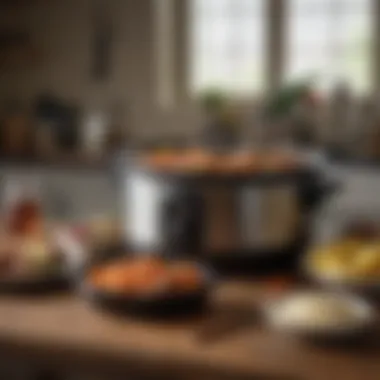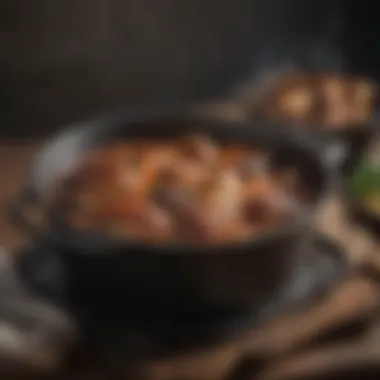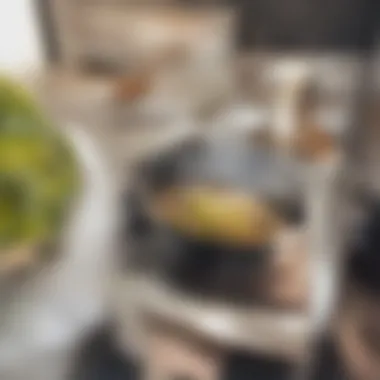Crock Pot vs. Dutch Oven: Which is Better for Cooking?


Intro
In the realm of home cooking, the choice of cookware can significantly influence both the process and the outcome of a dish. Among the myriad of options available, crock pots and cast iron Dutch ovens stand as two of the most widely used tools. Each has its advantages and unique characteristics that cater to different cooking needs. The purpose of this article is to explore these two beloved kitchen appliances in depth, providing a comprehensive analysis that highlights their respective strengths, cooking techniques, and overall utility.
Both of these cooking vessels are renowned for their ability to create warm and hearty meals, but they approach this goal in different ways. This exploration aims to equip home cooks—whether novice or experienced—with the knowledge necessary to choose the right tool for specific culinary tasks. As we navigate through the characteristics of these two appliances, we will also touch upon care instructions, the impact of cooking materials on flavors, and practical considerations when selecting which is best suited for your kitchen.
By examining the various facets of both crock pots and cast iron Dutch ovens, readers will gain insight that is both informed and actionable. Let’s begin by outlining the foundational aspects of each appliance and how they fit into the kitchen landscape.
Intro to Cooking Methods
Understanding different cooking methods is key for any food lover. Each method has its strengths and limitations. In this article, we will explore two popular cooking tools: the Crock Pot and the cast iron Dutch oven. Each has unique features that cater to certain culinary needs, which is important for both novice and experienced cooks.
The choice of cooking method impacts the flavor, texture, and nutritional value of dishes. Knowing how to utilize these methods effectively can elevate home cooking. It is not just about convenience; it is also about getting the best results from your ingredients. Understanding how each method works prepares cooks to select the right appliance for their recipes.
Understanding Slow Cooking
Slow cooking is a technique that promotes tender results through low temperatures. The Crock Pot exemplifies this method beautifully. It cooks food over several hours, allowing flavors to meld and nutrients to be preserved. This method also requires little attention, making it suitable for busy lifestyles.
Slow cooking is highly adaptable. You can prepare anyone from stews to desserts. Common ingredients include meats, vegetables, and grains. The key is to use enough liquid, which helps to prevent sticking and provides necessary moisture. In essence, slow cooking is about extracting deep flavors without constant monitoring.
The Art of Braising
Braising combines wet and dry heat, making it ideal for tougher cuts of meat. This method often starts with searing to create depth of flavor followed by cooking in liquid. A Dutch oven is well-suited for this technique due to its heat distribution properties.
The process usually involves a few steps: start with browning the meat, add aromatics such as onions and garlic, then deglaze with wine or broth. Add the remaining ingredients and allow it to cook slowly. Braising transforms the fibrous tissue in meat, resulting in a tender and flavorful dish.
- Key elements of braising include:
- High initial heat for browning
- Liquid to prevent drying
- Long cooking duration for tenderness
Overall, mastering these cooking methods not only enhances flavor but also allows home cooks to experiment with a variety of dishes.
The Crock Pot: Features and Benefits
The Crock Pot, or slow cooker, is a staple in many kitchens. It is recognized for its convenience and ability to develop rich flavors over long cooking periods. This section explores its features, benefits, and specific elements that make Crock Pots a popular choice among home cooks. The differing functionalities highlight the importance of understanding how a Crock Pot fits into various culinary tasks.
Design and Functionality
The design of a Crock Pot is straightforward yet effective. It typically consists of a ceramic or stoneware pot housed within a heating base. This setup allows for even heat distribution, which is crucial when slow cooking. Users can set temperatures to low or high, enabling flexibility based on meal timing.
The functionalities extend to features like programmable timers, which allow for precise cooking management. Many models also come with automatic keep-warm settings. This makes the Crock Pot especially useful for busy lifestyles where food preparation needs to fit within a hectic schedule.
Ideal Cooking Scenarios
Crock Pots excel in certain cooking situations. They are particularly advantageous for:
- Stews and Soups: The long, slow cooking process allows flavors to meld intricately, resulting in a depth that is hard to achieve with rapid cooking methods.
- Casseroles: The ability to cook ingredients thoroughly without constant attention makes Crock Pots ideal for layered dishes.
- Meat Dishes: Cuts of meat that are tough benefit from the slow cooking method. It tenderizes the meat, making it succulent and infused with flavors.


These scenarios illustrate how the Crock Pot can cater to diverse recipes, making it a versatile tool for both novice and experienced cooks.
Energy Efficiency
One significant advantage of using a Crock Pot is its energy efficiency. Unlike conventional ovens, a Crock Pot consumes considerably less electricity. It usually operates at around 200 to 250 watts, allowing you to cook meals over several hours without a significant spike in your energy bill.
This efficiency not only benefits your wallet but also the environment. The slower cooking times result in less energy usage overall, making it an excellent choice for eco-conscious cooks.
Remember: The ability to set meals in a Crock Pot and have them ready after many hours allows for less time spent actively cooking, maximizing your day.
Overall, the Crock Pot stands out due to its practicality in a busy life, various cooking applications, and economical energy consumption. Its design and functionalities make it an essential appliance for many culinary tasks.
The Cast Iron Dutch Oven: An Overview
The cast iron Dutch oven holds a significant place in both traditional and modern kitchens, known for its unique characteristics and extensive range of uses. This cooking vessel stands out because of its material properties, which contribute to exceptional heat retention and distribution. Its versatility allows it to be effectively used for a variety of cooking methods, from slow-cooking stews to searing meats. As more home cooks look for durable and efficient tools, understanding the benefits and considerations associated with a cast iron Dutch oven becomes vital.
Material Composition and Heat Retention
Cast iron is made primarily from iron alloyed with a small amount of carbon and other elements. This composition allows it to have excellent heat retention properties, making it ideal for cooking dishes that require even heat. When heated, a cast iron Dutch oven retains that heat well, which is essential for dishes that need a longer cooking time. This quality also means food can remain warm after cooking without the need for additional heating.
Additionally, the cooking surface of a cast iron Dutch oven is often coated with enamel. This not only enhances the appearance but also aids in preventing food from sticking and reducing the likelihood of rusting. However, it is important to understand how to care for both bare cast iron and enameled versions to maintain their durability and ensure they last for years.
Versatility in Cooking Techniques
One of the primary advantages of a cast iron Dutch oven is its versatility. This appliance can be used on the stovetop or in the oven, making it suitable for a wide range of cooking techniques.
- Braising: It excels in braising meats and vegetables due to its ability to maintain consistent heat.
- Baking: Many cooks use it for baking bread, taking advantage of its ability to create a steamy environment that helps with crust formation.
- Frying: The thick walls allow for deep frying, with good oil retention, leading to evenly cooked food without excessive oil absorption.
- Slow Cooking: Like a slow cooker, a Dutch oven can also be used for low and slow cooking, leading to rich flavors as ingredients meld over time.
Because it adapts to many types of cooking, a cast iron Dutch oven can often replace several other kitchen tools, making it an efficient choice for both novice and experienced cooks.
Lifespan and Durability
Investing in a cast iron Dutch oven is an investment in durability. With proper care, these cooking vessels can last a lifetime, often passed down through generations. Unlike many other cookware materials, cast iron is incredibly resilient to daily wear and tear. Even if scratched or dented, it can still function effectively.
Regular seasoning is important for maintaining a cast iron's non-stick properties and preventing rust. Simple care routines, such as washing it by hand and ensuring it is thoroughly dried, will keep it in excellent condition.
Comparative Analysis of Cooking Platforms
In exploring the culinary landscape, a comparative analysis of cooking platforms serves to illuminate the unique strengths and drawbacks of two incredibly popular cooking tools: the crock pot and the cast iron Dutch oven. Understanding the distinctions between them can incredibly impact not only cooking efficiency but also food quality and flavor enhancement. This analysis focuses on specific elements such as cooking times, flavor development, and ease of use.
Cooking Times
Cooking times are a vital aspect to consider. The crock pot allows for slow cooking, often ranging from four to eight hours, making it ideal for busy schedules. Meals can be prepared in the morning and left to cook throughout the day. This hands-off approach appeals to many home cooks.
In contrast, the cast iron Dutch oven typically requires more active cooking time. It can be used on the stove or in the oven, with cooking times varying based on the specific recipe. For example, a stew might take about two to three hours, while a roast could take significantly longer, depending on size and desired doneness. This platform may demand more attention, as it often requires stirring or checking to prevent burning.
Flavor Development Mechanics


Flavor development mechanics also differ between the two platforms. The crock pot excels in melding flavors over long cooking periods. Ingredients release natural juices and flavors, creating a cohesive and deeply flavored dish. The gentle, consistent heat allows for tender meats and soft vegetables.
On the other hand, the cast iron Dutch oven offers superior browning capabilities. Cooking at high temperatures can create that much-coveted Maillard reaction, which develops complex flavors. Searing meat first before adding liquids can enrich the overall flavor of the dish. This method is often ideal for stews, braises, and even baking, resulting in dishes with more pronounced flavors and textures.
Ease of Use and Cleanup
Ease of use is another critical consideration for many home cooks. The crock pot is predominantly user-friendly. Most models have simple controls and pre-set cooking times. Loading ingredients, selecting the settings, and walking away are its forte.
Cleanup, however, may vary. Some crock pots have removable, dishwasher-safe inserts, which simplifies the process. Conversely, cast iron Dutch ovens, while they often provide exceptional cooking performance, may require more effort during cleanup. Immediate washing or soaking is required to prevent food from sticking or rust forming. Seasoning is a necessary maintenance step to ensure longevity.
In summary, while both appliances have their unique benefits, the choice often comes down to personal preference and intended use. Each platform shines in specific scenarios, offering distinct advantages for those navigating their culinary paths.
Nutritional Aspects and Food Quality
In the realm of culinary arts, the relationship between cooking methods and nutritional integrity plays a significant role. Understanding how different appliances influence food quality can empower cooks to make informed decisions. This section centers on two primary themes: preservation of nutrients and the impact of cooking methods on flavor profiles. Both factors are crucial for anyone interested in maximizing the health benefits of their meals while also achieving satisfactory taste.
Preservation of Nutrients
Cooking techniques can significantly affect the nutritional value of food. For instance, slow cooking in a crock pot may preserve more vitamins and minerals compared to other methods, due to lower cooking temperatures and longer cooking times. This method allows ingredients to simmer gently, which can help retain water-soluble vitamins that might otherwise be lost through boiling or high-heat cooking.
However, it is essential to note that not all nutrition is preserved equally across all dishes. For instance, a large cut of beef cooked in a crock pot will release some collagen, which transforms to gelatin, adding health benefits to the broth. This is unlike a Dutch oven where browning and high-heat searing may cause some nutrient loss, while still enhancing flavor through the Maillard reaction.
Moreover, the shapes and materials of the cooking vessel can influence how evenly heat penetrates the food. A cast iron Dutch oven, known for its excellent heat retention, can simmer sauces and stews without requiring prolonged cooking times, which might also contribute to nutrient preservation.
Impact of Cooking Methods on Flavor Profiles
The method of cooking has a profound effect not just on nutrition but also on flavor dynamics. The crock pot primarily works through moist heat, which encourages the infusion of flavors as ingredients meld together over time. Dishes prepared in a crock pot tend to develop a deeper, more unified taste. This can be particularly beneficial for soups and stews where varied flavors can combine harmoniously.
On the other hand, the cast iron Dutch oven offers versatility that impacts flavor development in different ways. Its ability to reach high temperatures is ideal for browning meats and caramelizing vegetables, which adds layers of complex flavors not typically achievable in a crock pot. The added texture and taste derived from a well-browned surface can enhance the overall eating experience.
Key Insight: While the crock pot excels in nutrient retention due to its low and slow cooking style, the cast iron Dutch oven offers dynamic flavor development through high heat and direct contact with the cooking surface. Each method has its place in the kitchen, depending on the dish and desired outcome.
To summarize, understanding how cooking appliances affect nutrition and flavor is fundamental for cooks who wish to enhance the quality of their meals. In this comprehensive exploration, both crock pots and cast iron Dutch ovens bring their unique strengths, and the choice ultimately depends on personal cooking styles and objectives.
Practical Considerations for Home Cooks
When deciding between a Crock Pot and a cast iron Dutch oven, practical considerations play a crucial role. This section evaluates essential factors that can guide home cooks in their choices based on individual needs and kitchen situations.
One must consider various elements including cooking methods, cleaning difficulties, and the overall cost associated with each tool. Each cooking appliance offers unique benefits and caters to specific culinary tasks. Therefore, understanding these practical aspects enhances the cooking experience.
Choosing the Right Tool for Your Kitchen
Selecting the right cooking appliance requires thoughtful consideration. Firstly, think about your cooking style. If you often find yourself busy throughout the day, a Crock Pot could be beneficial. It allows you to prepare meals in advance and let the dish simmer throughout the day.
In contrast, a cast iron Dutch oven provides excellent versatility. It can be used on the stove or in the oven, allowing for various techniques like simmering, baking, or sizzling. When deciding, consider the types of meals you most enjoy cooking. For instance, if you love making stews or braising meats, both options perform well. However, if you prefer baking bread or making sauces, a Dutch oven might be more suited.
Key considerations for choosing the right tool:


- Cooking style: Are you more inclined toward slow cooking or oven roasting?
- Meal preparation: Do you prefer make-ahead meals or quick cooking?
- Versatility: Will you utilize the appliance for various cooking methods?
Cost Considerations and Budgeting
Cost also plays a significant role in choosing between a Crock Pot and a cast iron Dutch oven. Prices can vary based on brand, size, and features. A standard Crock Pot generally costs less than a Dutch oven. However, some high-end Dutch ovens can be seen as an investment due to their longevity and durability.
When budgeting, consider not only the initial purchase price but also the potential longevity of each tool. While a Crock Pot may have a lower upfront cost, a well-maintained Dutch oven can last a lifetime, serving multiple generations. Furthermore, the strong heat retention and versatility of cast iron may allow for energy savings during cooking.
To make an informed decision, assess your cooking frequency and evaluate how much you are willing to invest upfront versus over time.
"Investing in quality cooking tools can enhance the culinary experience and improve meal quality."
In summary, both practical and financial considerations are integral when deciding between a Crock Pot and a cast iron Dutch oven. Home cooks should carefully evaluate their preferences and needs to select the best tool for their kitchen.
Care and Maintenance of Each Appliance
Understanding the care and maintenance of cooking appliances is essential for ensuring longevity and optimum performance. Proper maintenance not only extends the life of the crock pot and cast iron Dutch oven but also preserves the quality of food prepared in these versatile tools. Each appliance comes with specific needs, which can significantly affect their usability and effectiveness in the kitchen.
Crock Pot Maintenance Tips
A crock pot is generally low-maintenance, yet some care practices enhance its performance over time. Here are several key tips to ensure its durability:
- Regular Cleaning: Post-cooking, allow the pot to cool before cleaning. Remove the stoneware insert and wash it with warm soapy water. Do not use abrasive cleaners, as they can scratch the surface.
- Avoid Submerging the Base: The electrical base should never be submerged in water. Instead, clean it with a damp cloth. This protects the wiring and the electronics within.
- Check Seals and Lid: Over time, rubber seals can wear out. Regularly inspect them for damage or wear to ensure airtight cooking, as a secure lid is vital for maintaining heat and moisture.
- Store Properly: When not in use, store the crock pot in a dry place. It is best to keep it uncovered to avoid moisture build-up, which can lead to mold or odor.
- Temperature Calibration: Occasionally check the temperature settings with a thermometer to ensure it is cooking accurately. If you find discrepancies, consult the manual for recalibration instructions.
Cleaning and Seasoning Cast Iron
Cast iron Dutch ovens necessitate a different approach regarding care due to their unique material properties. Here’s how to clean and season them:
- Immediate Cleaning: After use, let the Dutch oven cool down slightly. Use hot water and a stiff brush to remove food particles. Avoid soaking it in water, which can promote rust.
- Oil Application: After cleaning, dry the pot thoroughly using a towel, then apply a thin layer of vegetable oil or shortening. This step is essential to maintain the seasoning and prevent moisture from rusting the bare metal.
- Seasoning Process: For the best cooking performance, it is advised to periodically re-season the pot. To do this, apply a layer of oil and heat it upside down in an oven for about an hour. This creates a non-stick surface and enhances its natural properties.
- Storage: Store it in a dry area and consider placing a paper towel between the lid and the pot to allow airflow and absorb moisture.
The longevity and functionality of both appliances greatly depend on their maintenance. Taking the time to care for them can significantly enhance your cooking experience.
The End and Final Thoughts
In this exploration of the crock pot and cast iron Dutch oven, we touch on essential elements that influence a home cook's choice. Both appliances offer unique benefits, but their effectiveness varies depending on cooking styles and personal preferences.
When to Choose Each Option
Making a choice between a crock pot and a cast iron Dutch oven hinges on several factors. A crock pot excels in its convenience. It is ideal for those busy lifestyles where meal preparation requires minimal effort. If slow-cooked, tender meals are a focus, the crock pot's hands-off approach may suit you well. For example, dishes like chili and beef stew benefit from the prolonged cooking time.
On the other hand, the cast iron Dutch oven offers exceptional versatility. It can handle higher temperatures, making it perfect for searing proteins or baking artisan bread. If you enjoy a cooking experience that includes various techniques, such as braising or baking, then the Dutch oven is a compelling choice. Moreover, traditionalists might appreciate how it retains heat and moisture, which can dramatically enhance flavors.
In summary, select a crock pot for effortless, slow cooking, while a cast iron Dutch oven offers broader culinary applications for the engaged home chef.
Future Trends in Cooking Appliances
The cooking appliance landscape is evolving rapidly, influenced by innovation and changing consumer demands. One notable trend is the rise of smart appliances. Many modern crock pots are now equipped with Wi-Fi connectivity, allowing users to monitor and adjust settings remotely. This can be particularly beneficial for busy individuals or families.
Furthermore, research on materials continues. Manufacturers are focusing on healthier non-stick coatings or better heat distribution technology, enhancing performance in both crock pots and Dutch ovens.
Sustainability is also becoming a central theme. Consumer preferences are shifting toward eco-friendly materials and energy-efficient designs. This consideration may influence future development, leading to more durable products that not only perform well but also cause less environmental impact.
Ultimately, understanding these trends can help home cooks make informed decisions about what appliances will best enhance their culinary endeavors in the years to come.







